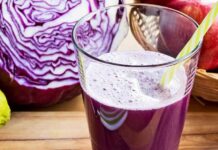
Smoothies are a popular choice for a speedy breakfast or a nourishing snack, but are they too high in sugar to enjoy regularly? Our expert nutritionist looks at the facts.
Quick to make and a useful strategy to tempt kids to eat more fruit and veg, it’s easy to see the appeal of smoothies. A blended puree of fruit and vegetables with a liquid base of juice, milk or yogurt, smoothies contain more fibre than the equivalent glass of juice.
What’s The Problem With Smoothies?
There are a number of benefits from consuming smoothies, they increase fibre intake, contribute towards our 5 a day, boost our vitamin C levels, and may help with conditions like high blood pressure.
However, when we blend or juice fruit, we’re breaking down the plant cell walls and exposing the natural sugars within. This effectively turns the sugars into ‘free sugars’, the type we are advised to cut back on.
Free sugars may lead to dental decay, provide excess calories and cause a rapid rise in blood sugar levels. For these reasons it’s best to enjoy your smoothie with other food, ideally at mealtimes, and to limit the number of glasses you consume. Smoothies and juices only count as one of your five-a-day, regardless of the number of different fruit or vegetables used or the number of glasses you drink.

Should Children Drink Smoothies?
Water and milk are the best drinks for young children, but smoothies are an option and offer an opportunity for you to include foods that your child might otherwise not eat. They’re also useful for children who have a poor appetite, as well as teenagers who are always on-the-go. Unlike juices, smoothies retain the whole fruit, including the fibre, but don’t forget they are a source of ‘free’ sugars, which should make up no more than 5% of our energy (calorie) intake.
Another thing to consider is that because we drink smoothies rather than eat them, we do tend to consume them more quickly. This means the sugars they contain may flood the bloodstream and, because no chewing is involved, the body doesn’t get the same messages that help us regulate how much we eat.
For these reasons, what you use to make your smoothie is important – ideally choose a combo of vegetables, dairy or nut butters and some fruit. This will ensure your smoothie contributes vitamins, minerals, protein and fibre. As adults we often add protein powders and other supplements to our own smoothies; these should never be added to a child’s smoothie.
It’s important to remember that whole fruit and vegetables should always be included as part of a balanced diet – this is especially important for young children who are learning to eat and are forming their own food preferences.
Is There A Difference Between Homemade And Shop-Bought?

Many shop-bought smoothies are made from cheaper, more processed ingredients such as fruit purées and juices. These purées concentrate sugars whilst removing many of the nutritional benefits of the whole fruit such as the fibre, phyto-nutrients, vitamins and minerals. Some shop-bought smoothies are also sold in sizes larger than the recommended 150ml portion size and have added nutrients such as B vitamins as well as vitamins C and E.
Homemade smoothies, on the other hand, contain all of the fibre and will be naturally vitamin-rich because they’re freshly made and ideally consumed straight away.
Should You Use Fresh Or Frozen Fruit?
Studies suggest that certain nutrients, including vitamin C, are comparable and occasionally higher in fruit (and vegetables) that have been frozen at harvest, compared to their fresh equivalent. Although, beta-carotene, which the body converts to vitamin A, may reduce on freezing. That said, it will depend on the fruit or vegetable in question.
Overall, whether you choose fresh or frozen produce for your smoothie, it doesn’t really matter. Both count towards your five-a-day and, if by using frozen produce, you’re increasing your daily intake, then that has to be a good thing. Frozen produce may also help keep weekly food bills down, allows you to enjoy out of season crops and are a useful stand-by when you can’t get to the shops.
What Is A Correct Portion Size?
The guidance for the majority of us is to limit our daily intake of smoothies and juices to one glass of 150ml. This contributes a maximum of one of our five-a-day.
For a child, a smoothie portion will depend on their age and activity levels. A useful tip is to only use the amount of food a child would eat if the food was offered to them whole, rather than blended.

Which Fruit Is Best For Smoothies?
Using a combination of fruit with veggies will help keep the sugar content of your homemade smoothie down. Lower sugar fruits include berries, fruits with stones such as peaches, apricots and plums, as well as citrus fruits, kiwi and avocado. These may be combined with vegetables including leafy greens like spinach and kale, as well as celery, cucumber and beetroot.
How Often Should You Drink Smoothies?
Smoothies may form part of a balanced diet, but be sure to focus on lower sugar fruits, emphasising fresh or frozen produce. Include one or more sources of protein like yogurt, kefir or milk, as well as healthy fats from nuts, seeds or avocado. Both adults and children should consume smoothies no more than one portion per day.
Important Notice: This article was originally published at www.bbcgoodfood.com by Kerry Torrens – Nutritionist where all credits are due.
Disclaimer
The watching, interacting, and participation of any kind with anything on this page does not constitute or initiate a doctor-patient relationship with Dr. Farrah™. None of the statements here have been evaluated by the Food and Drug Administration (FDA). The products of Dr. Farrah™ are not intended to diagnose, treat, cure, or prevent any disease. The information being provided should only be considered for education and entertainment purposes only. If you feel that anything you see or hear may be of value to you on this page or on any other medium of any kind associated with, showing, or quoting anything relating to Dr. Farrah™ in any way at any time, you are encouraged to and agree to consult with a licensed healthcare professional in your area to discuss it. If you feel that you’re having a healthcare emergency, seek medical attention immediately. The views expressed here are simply either the views and opinions of Dr. Farrah™ or others appearing and are protected under the first amendment.
Dr. Farrah™ is a highly experienced Licensed Medical Doctor certified in evidence-based clinical nutrition, not some enthusiast, formulator, or medium promoting the wild and unrestrained use of nutrition products for health issues without clinical experience and scientific evidence of therapeutic benefit. Dr. Farrah™ has personally and keenly studied everything she recommends, and more importantly, she’s closely observed the reactions and results in a clinical setting countless times over the course of her career involving the treatment of over 150,000 patients.
Dr. Farrah™ promotes evidence-based natural approaches to health, which means integrating her individual scientific and clinical expertise with the best available external clinical evidence from systematic research. By individual clinical expertise, I refer to the proficiency and judgment that individual clinicians acquire through clinical experience and clinical practice.
Dr. Farrah™ does not make any representation or warranties with respect to the accuracy, applicability, fitness, or completeness of any multimedia content provided. Dr. Farrah™ does not warrant the performance, effectiveness, or applicability of any sites listed, linked, or referenced to, in, or by any multimedia content.
To be clear, the multimedia content is not intended to be a substitute for professional medical advice, diagnosis, or treatment. Always seek the advice of your physician or other qualified health providers with any questions you may have regarding a medical condition. Never disregard professional medical advice or delay in seeking it because of something you have read or seen in any website, video, image, or media of any kind. Dr. Farrah™ hereby disclaims any and all liability to any party for any direct, indirect, implied, punitive, special, incidental, or other consequential damages arising directly or indirectly from any use of the content, which is provided as is, and without warranties.








